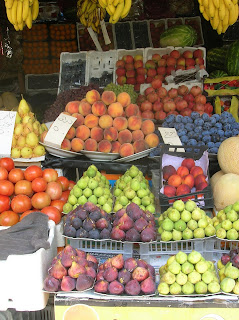
The best thing about my old neighborhood in Damascus, Muhajereen, is the sprawling market tucked up into the slope of the mountain-side. Muhajereen is a middle class conservative neighborhood whose northern location offers sprawling city views; for me, I was drawn by the affordable rent on good-quality appartments and proximity to my office. But I was soon to discover that the best thing about Muhajereen is the souq al-jumoaa, or the market. At the end of al-Afif Street, where the road climbs up the mountain past an eighteenth century mosque and a little lane trundles past some occupied Ottoman-era buildings, is the market’s entrance.


Summer figs, peaches, and unusual fruits.
In Arabic, when someone says they’re going to the market (souq), it could mean anything from going around the corner for some milk to a full afternoon of clothes shopping in the hippest area. Similarly, the market sells just about anything, though it’s primary trade is in fruits, vegetables, meats, cheeses, and breads. Muhajereen’s souq al-jumoaa is particularly expansive, running the equivalent of about 10 blocks packed with vendors in winding streets. A small square halfway through the market fronts onto a mosque which holds the tomb of a famous Sufi leader. In the mornings, clusters of women walk through in their long black robes. The women wear a full black cloth over their faces so that no features are distinguishable, most wear black gloves. Occaisionally, they lean over to inspect the quality of some tender lettuces or a new blender, deftly flipping up and then lowering their veil in a single motion for a clearer view. All the vendors are men.


Making pancakes for qatayaf, romaine lettuce.
On Friday mornings my favorite thing to do is to stroll the market, when it bustles in the morning light. I am the only foreigner but no-one pays to much attention. I visit the cheese man with the saltiest, creamiest feta and the little balls of shankleesh. At the baker, I get the little crunchy yellow cookies with anise seeds in them. I side-step the blood that runs near the area of the meat-market where full carcasses are strung up in the open air. There is always a surprise in the form of an unusual vegetable I’ve never seen, or some tiny berries that will only be available that week.
 A Middle Eastern market is not a place to be squeemish about meat.
A Middle Eastern market is not a place to be squeemish about meat.Whenever I had visitors, I always took them to my local market. In part, the excitement of the market is representative of how little else there is to do here, movies, sports, and theater exist but are primarily fodder for the upper classes. However, the market is also symbolic of a society that revolves around sharing a daily meal with your family, the joys of preparing and eating food together, of living by the season and discovering the daily bounty of nature.

Tomato and Shankleesh Salad
Shankleesh (شنكليش) is a Middle Eastern cheese (also known as sorke) which is shaped into round balls and rolled in either red pepper or zaatar. As the cheese ages it acquires a crumbly texture and pungent flavor. A salad of chopped tomatoes, onion, and shankleesh is a standard addition to any mezze table and often accompanied by arak (an anise-scented liquor).
2-3 balls shankleesh, depending on their size
3 ripe tomatoes, chopped
2 tbl diced onion
pinch of salt
Mix all ingredients, crumbling the cheese with your fingers. Serve immediately with pita bread and arak.
Unfotunately, shankleesh is generally unavailable outside the Middle East, for a discussion on how to make it, see here. There's no real substitute for shankleesh, but I find a mixture of half goat cheese and half blue cheese along with a generous pinch of Aleppo pepper is a good alternative. I use about 3 oz of each cheese, usually chevre or fresh crottin for the goat cheese, and a tangy blue cheese like Bleu d'Auvergne, Roquefort, or Maytag blue.






No comments:
Post a Comment